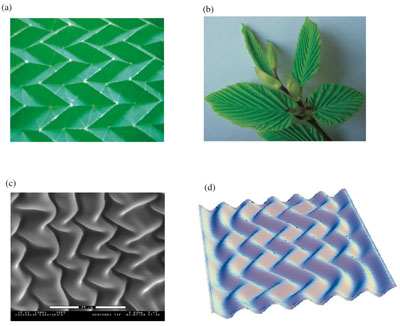Self-Assembly of Supported and Unsupported Thin Films

The controlled folding and unfolding of maps, space structures, wings, leaves, petals and other foldable laminae is complicated by the independence of individual folds; as their number increases there is an explosion in the number of possibilities. The artificially constructed origami pattern with a periodic array of geometrically and elastically coupled mountain and valley folds shown above circumvents this complication by allowing the entire structure to be folded or unfolded simultaneously. Making such a pattern is not easy, yet an elegant natural counterpart, leaves, petals, insect wings, and other laminae, start as these origami structures, suggesting that these patterns result from convergent design. This raises the question of mechanism: how might this spatial organization of folds be brought about? A plausible answer involves the role of initial curvature which can allow folding structures in pre-determined ways in three dimensions.
Harvard MRSEC (DMR-0820484)
